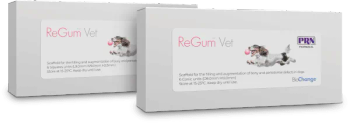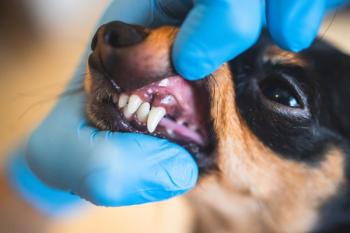
Oral surgery solutions: An unerupted canine tooth and a challenging full mouth extraction
Unexpected complications can surprise even experienced veterinary specialists. Consider referring complex surgery cases to avoid taking on more than you bargained for.
In the February issue of dvm360, we looked at two difficult cases in veterinary dentistry. In this second article in this series examining challenging oral surgery cases, we’ll discuss how to know when referral is appropriate. If your dental surgery skills are less than refined, especially complex or unusual oral surgery cases are best left to board-certified experts.
Unerupted canine tooth in a cat and subsequent complications
A 2½-year-old domestic shorthaired cat was presented for evaluation of a mass at the site of a missing right maxillary canine tooth (104). History was unclear as to whether a tooth ever was present at the site of the mass. The mass was fluctuant and had a bony rim around its base (Figure 1). Dental radiographs were taken and revealed a canine tooth within the right maxilla (Figure 2). The apical extent of the tooth extended to the level of the furcation of the right maxillary fourth premolar (108). The presumptive diagnosis was a dentigerous cyst associated with the unerupted canine tooth. The mass was likely a result of the cyst impingement on the gingiva and bone at this location.
Figure 1: Image of a 2½-year-old domestic shorthaired cat presented for evaluation of a mass at the site of a missing right maxillary canine tooth. (All photos courtesy of Dr. Brett Beckman.)
Figure 2: A dental radiograph demonstrating a canine tooth within the right maxilla.
The surgical approach was similar to that utilized in a maxillary canine tooth extraction, with a mesial vertical releasing incision and a distal envelope incision in the sulcus (Figure 3). The bony rim was removed at the base of the mass, increasing exposure. The caudal portion of the cyst extended ventral to the orbit (Figure 4). The bone adjacent to the nasal cavity and the rostral maxillary recess was destroyed. No fluid existed within the defect, which was lined by a fibrous tissue consistent with that of a cyst (Figure 5).
Figure 3: The surgical approach was similar to that utilized in the maxillary canine tooth extraction.
Figure 4: A dental radiograph demonstrating a suction wand extending to the caudal extent of the defect.
Figure 5: An example of the material that was removed and submitted for histopathologic examination.
Careful removal of all discernible cyst material was difficult due to hemorrhage and obscurity of normal architecture. The pet owner was informed that although recurrence was possible, an aggressive approach involving complete removal provided a good prognosis. Closure was completed by excising excess marginal and palatal gingiva and suturing with 5-0 monocryl (Figure 6).
Figure 6: The closure was accomplished by excising excess marginal and palatal gingiva and suturing with 5-0 monocryl.
Histopathologic examination confirmed a dentigerous cyst. Dehiscence of a portion of the flap was recognized at the 30-day recheck, along with a small lip lesion secondary to canine tooth impingement (Figure 7). The lip lesion was not clinically significant and palpation revealed no discomfort. The defect was debrided and closed. Healing was complete at the subsequent recheck (Figure 8).
Figure 7: The surgical site 30 days after surgery showing dehiscence of a portion of the flap along with a small lip lesion secondary to canine tooth impingement.
Figure 8: Image demonstrating healing at the subsequent recheck.
Six months after the recheck, the patient presented with a space-occupying mass ventral to the orbit (Figure 9). Attempted excisional biopsy of what was thought to be residual cyst epithelium surprisingly revealed very aggressive undifferentiated neoplasia on histopathologic examination. Classification by immunohistochemical staining was declined due to a very poor prognosis based on pathology. The patient was euthanized several weeks later due to progression of the mass.
Figure 9: The patient six months after the 30-day recheck with a space-occupying mass ventral to the orbit.
Atypical generalized tooth discoloration in a Caribbean rescued setter mix
A rescued setter mix from a Caribbean island, age unknown, with no significant history was referred to our Atlanta office by a veterinary dental colleague who had examined the patient while on vacation. The patient presented with generalized yellow and brown tooth discoloration (Figure 10). Generalized tooth discoloration is a common presentation in patients that have undergone a febrile event during the development of the enamel, also called amelogenesis. This results in enamel hypocalcification and hypoplasia. These cases generally demonstrate patchy discoloration and irregular defects, often reaching the level of the dentin. However, in this patient, the enamel was smooth with no irregularities. This more often is associated with an ingested substance, usually fluoride or tetracycline, and frequently this results in no other tooth aberrations.
Figure 10: The left maxillary and mandibular teeth of a rescued setter mix presented for generalized tooth discoloration.
Despite the contention that this condition was likely due to an ingested substance, full mouth radiographs are indicated in all cases of tooth discoloration. Dentin dysplasia in particular may occur in combination with enamel defects since the genesis of both tissues overlap. The patient was anesthetized and oral examination revealed a fistulous tract apical to the mucogingival junction (Figure 11). A lesion at or apical to the mucogingival junction is commonly secondary to a nonvital tooth and indicates bone lysis secondary to pulp necrosis.
Figure 11: A fistulous tract (white arrow) apical to the mucogingival junction (black arrows).
Radiographs of that region demonstrated a large lucency associated with the mesial and distal roots of the right mandibular first molar (409) (Figures 12A and 12B). The pulp cavity diameter of 409 was much larger than that of the adjacent teeth. Most of the remaining teeth had similar defects (Figures 13 and 14).
Figure 12A: A radiograph of the region associated with the fistula (tooth 409) demonstrating a large lucency associated with the distal root.
Figure 12B: A radiograph of the mesial root of tooth 409 showing a large lucency.
Figure 13: Four of the five incisors in this radiograph showing increased pulp cavity diameter versus that of the right maxillary first incisor (arrow) indicating non-vitality.
Figure 14: Large pulp diameters and periapical lucencies are present on both mandibular canine teeth.
Due to the extensive involvement of the majority of the teeth and the difficulty in obtaining adequate follow-up for the few radiographically normal teeth that remained, full mouth extraction was recommended. Four quadrant nerve blocks were administered. Full quadrant, full thickness mucogingival flaps (excluding the incisors) for surgical exposure were extremely difficult to raise. The periosteum was thickened and attached very firmly to the underlying bone.
It was thought that the event that resulted in discoloration also altered the interface of the bone, periosteum or both, making the interface of the bone and periosteum difficult to separate. Teeth were unusually difficult to remove, requiring exposure to the apex in most instances (Figures 15 and 16). These factors added considerably to the time for extractions. Two hours and forty minutes were required to remove two quadrants plus the incisors. Hand fatigue, cramping and patient temperature concerns necessitated waking the patient and completing the extractions the following day. The nerve blocks were repeated and an opiate added to extend the duration of the blocks. This was repeated the next day prior to completion of the extractions.
Figure 15: Surgical exposure of the right mandibular quadrant was needed to aid in efficient extraction.
Figure 16: A bone defect was present adjacent to tooth 409 and the region of fistulation (arrow).
One hour and forty minutes were needed to complete the second procedure. Although antibiotics are not generally needed for most oral surgical procedures, this case included a high level of bone involvement, and a dose of clindamycin appropriate for treating osteomyelitis was administered for three weeks. The day after the second procedure, the owner returned for a recheck prior to the trip back to home. Although no discomfort had been recognized at home previously, the owner reported a significant difference in his dog’s demeanor, indicating that he was more energetic and ate very well. Palpation of all quadrants was tolerated and revealed minimal to no discomfort. In follow-up communication with the owner, he has described an extremely happy patient that plays constantly with significantly improved demeanor and activity levels compared with before the surgery.
Full mouth extractions in veterinary patients should be performed only by board-certified veterinary dentists or those with extensive experience in extractions. In this case, the difficulty with flap exposure and removal was unexpected and added considerable time to the procedure. In the hands of an inexperienced operator, this procedure could have resulted in numerous complications.
Dr. Brett Beckman lectures and sees patients at Affiliated Veterinary Specialists, Orlando, Fla.; Florida Veterinary Dentistry and Oral Surgery, Punta Gorda, Fla.; and Animal Emergency Center of Sandy Springs, Atlanta. Visit veterinarydentistry.net for more information.
Newsletter
From exam room tips to practice management insights, get trusted veterinary news delivered straight to your inbox—subscribe to dvm360.






